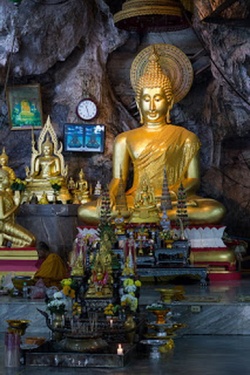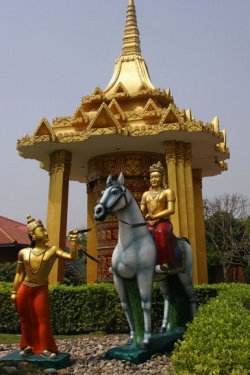Nirvana Sutra
Nirvana Sutra
[涅槃経] (Chin Nieh-p’an-ching; Jpn Nehan-gyo )
Any of the sutras either recording the teachings that Shakyamuni Buddha expounded immediately before his death or describing the events surrounding his death, or entry into nirvana. There are both Mahayana and Hinayana Nirvana sutras in Chinese translation. (Note: Where the titles of Chinese Nirvana sutras are phonetic transliterations from Sanskrit, the Sanskrit names are given for convenience's sake. Those titles that were translated into Chinese are given in English.)
Chinese Mahayana versions include:
(1) The Mahaparinirvana Sutra, a translation by Dharmaraksha of the Northern Liang dynasty (397-439). This is the so-called northern version, consisting of forty volumes and thirteen chapters. It teaches that the Dharma body of the Buddha is indestructible and eternal; that the state of nirvana is endowed with the four virtues of eternity, happiness, true self, and purity; that all living beings possess the Buddha nature; and that even icchantikas, or persons of incorrigible disbelief, can attain Buddhahood.
(2) The Mahaparinirvana Sutra (southern version), a translation by Hui-kuan, Hui-yen, and Hsieh Ling-yyn of the Liu Sung dynasty (420-479). This is a revision of the northern version in light of the Mahaparinirvana Sutra translated by Fa-hsien and Buddhabhadra, and consists of thirty-six volumes and twenty-five chapters.
(3) The Mahaparinirvana Sutra, a translation by Fa-hsien and Buddhabhadra in the Eastern Chin dynasty (317-420). This work consists of six volumes and corresponds to the first ten volumes of Dharmaraksha's version. It is also called the Parinirvana Sutra or the six-volume Parinirvana Sutra.
(4) The Epilogue to the Mahaparinirvana Sutra, a two-volume translation by Jnanabhadra and Hui-ning of the T'ang dynasty (618-907), in which Shakyamuni Buddha describes the practice his disciples should carry out after his death. This sutra also describes the cremation of the Buddha's body, the distribution of his ashes, etc. Fragments of the Sanskrit texts from which these translations were made are extant.
The Hinayana Nirvana sutras are not so much expositions of Shakyamuni Buddha's teachings as descriptions of the final events of his life, his entry into nirvana, and the distribution of his remains.
There are five Chinese versions:
(1) the two-volume Buddha's Parinirvana Sutra, a translation by Po Fa-tsu of the Western Chin dynasty (265-316);
(2) the two-volume Parinirvana Sutra, translator unknown;
(3) the three-volume Mahaparinirvana Sutra, a translation by Fa-hsien of the Eastern Chin dynasty;
(4) the one-volume Legacy Teachings Sutra, a translation by Kumarajiva in the Later Ch'in dynasty (384-417); and
(5) the Sutra of Preaching Travels contained in the Long Agama Sutra, one of the four Chinese Agama sutras, which was translated by Buddhayashas and Chu Fo-nien in the Later Ch'in dynasty.
Among these five Chinese translations, only the Legacy Teachings Sutra is devoted to the expounding of doctrine rather than descriptions of the Buddha's final travels. Therefore, some scholars do not regard it as one of the Hinayana Nirvana sutras. The thirty-fifth through fortieth volumes of The Monastic Rules of the Sarvastivada School on Various Matters, a translation by Iching, is similar in content to the four Hinayana versions other than the Legacy Teachings Sutra. In addition to these Chinese versions, there is also a Pali text called the Mahaparinibbana-suttanta, whose content resembles that of the Chinese Hinayana versions. See also Mahaparinirvana Sutra.

